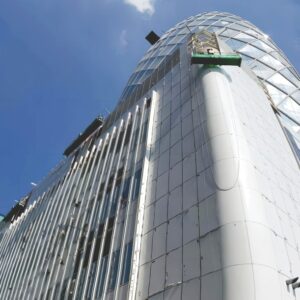Introduction

The Significance of Aluminum Plates
Aluminum plates, renowned for their remarkable combination of lightweight and high strength, have become an essential material in a multitude of industries. From the sleek frames of modern aircraft to the sturdy structures of high-rise buildings, and from the intricate casings of electronic devices to the hygienic surfaces of food processing equipment, aluminum plates are ubiquitous. Their corrosion resistance and excellent thermal conductivity further expand their range of applications, making them a go-to choice for everything from automotive manufacturing to heat exchangers. In the automotive sector, aluminum plates contribute to enhanced fuel efficiency and vehicle performance. In architecture, they offer both aesthetic appeal and durability. The versatility of aluminum plates is truly astounding, and their importance in modern industrial manufacturing cannot be overstated.
Purpose of the Article
The aim of this comprehensive article is to provide a detailed and in-depth understanding of aluminum plate specifications. Whether you are an engineer involved in the design and construction of complex machinery, a manufacturer seeking to optimize material selection for your products, or a procurement specialist responsible for sourcing the right aluminum plates, this article will serve as an invaluable resource. By delving into the various aspects of aluminum plate specifications, including dimensions, thickness, alloy compositions, mechanical properties, surface finishes, and quality standards, readers will be equipped with the knowledge necessary to make informed decisions. This will not only ensure the successful completion of projects but also contribute to cost savings and the overall enhancement of product quality.
Aluminum Plate Basics

Definition and Composition
Aluminum plates are flat, rigid sheets of aluminum metal that have been processed and manufactured to specific thicknesses and dimensions. They are typically made from aluminum alloys, which are combinations of aluminum with other elements to enhance specific properties. Common alloying elements include copper, magnesium, manganese, silicon, and zinc. For example, the addition of copper improves the strength of the alloy, making it suitable for applications where high mechanical stress is involved, such as in aerospace components. Magnesium, on the other hand, enhances the corrosion resistance and weldability of the aluminum plate. Silicon is often added to improve the fluidity of the molten alloy during casting, which is beneficial for manufacturing complex shapes. These alloying elements, in varying proportions, allow aluminum plates to exhibit a wide range of properties, from high strength and hardness to good formability and corrosion resistance.
Common Applications
The versatility of aluminum plates leads to their extensive use in numerous industries. In the aerospace industry, aluminum plates are used for the construction of aircraft fuselages, wings, and other structural components due to their lightweight and high strength-to-weight ratio. This helps reduce the overall weight of the aircraft, leading to improved fuel efficiency and performance. In the automotive sector, they are employed for body panels, engine parts, and chassis components, contributing to lighter and more fuel-efficient vehicles. For instance, the hoods and doors of many modern cars are made from aluminum plates. In architecture, aluminum plates are used for cladding, roofing, and decorative elements. Their corrosion resistance and ability to be easily formed into different shapes make them ideal for creating aesthetically pleasing and durable building exteriors. They can also be found in the electronics industry for heat sinks and enclosures, as aluminum’s good thermal conductivity helps dissipate heat generated by electronic components. Additionally, aluminum plates are used in the food and beverage industry for processing equipment and storage containers due to their non-toxic and corrosion-resistant properties. They are also utilized in the manufacturing of marine vessels, sporting goods, and many other consumer and industrial products.
Key Specifications
Thickness
Standard Thickness Ranges
Aluminum plates are available in a wide range of thicknesses to meet diverse application requirements. The most commonly used thickness intervals range from 0.2 mm to 600 mm. For applications in the electronics industry, such as the production of circuit boards and heat sinks, thinner aluminum plates with a thickness of 0.2 mm to 2 mm are often preferred. These thin plates offer good thermal conductivity and are easy to process and integrate into electronic devices. In the automotive industry, body panels and some structural components may utilize aluminum plates with a thickness of 0.8 mm to 3 mm. For example, the hoods of many cars are made from aluminum plates around 1 mm thick, which helps reduce the vehicle’s weight while maintaining sufficient strength. In the construction of high-rise buildings and bridges, thicker aluminum plates ranging from 5 mm to 600 mm are employed. The structural columns and beams of some large-span bridges may use aluminum plates with a thickness of several centimeters to ensure the stability and load-bearing capacity of the structure.
Measurement Tolerances
The measurement tolerance of aluminum plate thickness is a crucial factor that affects the precision and quality of manufacturing. Thickness tolerances are defined based on industry standards and specific application needs. For general industrial applications, the thickness tolerance of aluminum plates is usually within ±0.1 mm to ±0.5 mm. In the aerospace industry, where high precision is required, the thickness tolerance can be 严格控制在 within ±0.05 mm or even narrower. For example, in the manufacturing of aircraft wings, the aluminum plates used must have extremely precise thickness control to ensure the aerodynamic performance and structural integrity of the wings. The reason for strict control of thickness tolerance is that even a slight variation in thickness can affect the mechanical properties, assembly accuracy, and overall performance of the final product. If the thickness tolerance is too large, it may lead to problems such as improper fit during assembly, reduced strength of the structure, and uneven stress distribution.
Width and Length
Available Dimensions
Aluminum plates come in a variety of standard width and length options. Common widths range from 100 mm to 3000 mm, while lengths can vary from 200 mm to 12000 mm. In the furniture manufacturing industry, narrower and shorter aluminum plates are often used. For instance, the frames of some small furniture pieces may use aluminum plates with a width of 200 mm to 500 mm and a length of 500 mm to 1000 mm. In the construction of large industrial plants and warehouses, wider and longer aluminum plates are required. Roofing and siding materials may use aluminum plates with a width of 1000 mm to 3000 mm and a length of several meters to tens of meters to cover large areas efficiently.
Customization Possibilities
When standard dimensions do not meet specific project requirements, aluminum plates can be customized. The customization process involves considering factors such as production costs, manufacturing time, and the availability of raw materials. Custom-sized aluminum plates are often required in the manufacturing of specialized machinery and equipment. For example, a unique piece of industrial equipment may need an aluminum plate with a specific width and length to fit its particular design and function. However, customization may lead to increased costs and longer production lead times compared to using standard-sized plates. Manufacturers need to carefully weigh the benefits and drawbacks and make decisions based on the overall project requirements and budget constraints.
Aluminum Plate Alloys

Popular Aluminum Alloys for Plates
Aluminum alloys play a crucial role in determining the properties and applications of aluminum plates. Three of the most popular aluminum alloys for plates are 6061, 5052, and 7075, each with its own distinct characteristics and ideal usage scenarios.
The 6061 aluminum alloy is a heat-treatable alloy that contains magnesium and silicon as the main alloying elements. It exhibits good strength, excellent corrosion resistance, and has relatively good formability. It can be easily machined, welded, and anodized. Due to these properties, 6061 aluminum plates are widely used in the aerospace industry for structural components such as aircraft frames and wings that require a combination of strength and lightweight. In the automotive sector, it is also employed for parts like engine mounts and chassis components where moderate strength and good corrosion resistance are needed. For example, some aftermarket automotive performance parts, like suspension components, are often made from 6061 aluminum plates to reduce weight without sacrificing too much durability.
The 5052 aluminum alloy is mainly alloyed with magnesium. It has outstanding corrosion resistance, especially in marine environments and applications where exposure to moisture and chemicals is common. It also offers good formability and moderate strength. This makes 5052 aluminum plates a top choice for applications in the marine industry, such as boat hulls, decks, and other structural parts that need to withstand the corrosive effects of saltwater. In the food and beverage industry, 5052 aluminum plates are used for storage tanks and processing equipment due to their non-toxic nature and resistance to corrosion from various food acids and cleaning agents. For instance, many aluminum food containers that are in direct contact with food items are made from 5052 alloy.
The 7075 aluminum alloy is a high-strength alloy that contains zinc as one of the major alloying elements along with magnesium and copper. It has extremely high strength, making it suitable for applications where heavy loads and high mechanical stress are involved. However, its corrosion resistance is relatively lower compared to 6061 and 5052 alloys, and it can be more difficult to machine and weld. 7075 aluminum plates are predominantly used in the aerospace industry for critical structural parts that need to bear significant loads, like landing gear components and certain high-stress areas in aircraft fuselages. In the sports equipment industry, it is used for making high-performance items such as bicycle frames for racing bikes and some parts of golf clubs where light weight combined with high strength is essential.
Alloy Selection Considerations
When choosing an aluminum alloy for plates, several factors need to be carefully considered, including strength, corrosion resistance, weldability, and cost implications.
Strength is a vital aspect depending on the specific application. For structural applications in industries like aerospace, automotive, and construction, alloys with higher strength, such as 7075 or 6061, are preferred. High-strength alloys ensure that the components can withstand the mechanical forces and loads they will experience during operation. For example, in the construction of a bridge using aluminum plates, the choice of an alloy with adequate strength is crucial to maintain the structural integrity and safety of the bridge under various traffic and environmental loads.
Corrosion resistance is another key consideration. In applications where the aluminum plates will be exposed to harsh environments like seawater in marine applications or outdoor weather conditions in architecture, alloys with excellent corrosion resistance like 5052 are more suitable. Corrosion can lead to degradation of the material over time, reducing its performance and lifespan. For instance, aluminum siding on a building made from a corrosion-resistant alloy will maintain its appearance and structural stability for a longer period compared to one made from an alloy with poor corrosion resistance.
Weldability is important for manufacturing processes where the aluminum plates need to be joined together. Some alloys, like 6061, have relatively good weldability, allowing for easy fabrication of complex structures through welding techniques. However, alloys like 7075 can be more challenging to weld due to their chemical compositions and the potential for cracking or other welding defects. Manufacturers need to assess the weldability requirements of their projects and choose the appropriate alloy accordingly.
Cost implications also play a significant role in alloy selection. Generally, alloys with more exotic or rare alloying elements and higher performance characteristics tend to be more expensive. For example, 7075 aluminum alloy, with its high strength properties, may cost more than 5052 alloy. In some applications where cost is a major constraint and the required strength and other properties can be met with a less expensive alloy, a more budget-friendly option like 5052 or a lower grade of 6061 might be chosen. For instance, in the production of some consumer goods where the performance requirements are not extremely high but cost control is essential, a more affordable aluminum alloy will be selected to optimize the overall production cost while still meeting the basic functionality and durability needs.
Mechanical Properties
Tensile Strength
Tensile strength is a crucial mechanical property that determines the maximum amount of tensile stress a material can withstand before breaking. It is defined as the ratio of the maximum force applied during a tensile test to the original cross-sectional area of the specimen. For aluminum plates, tensile strength is of paramount importance as it directly relates to their load-bearing capacity. In applications such as aerospace and automotive industries, where aluminum plates are used in structural components, high tensile strength is essential to ensure the safety and integrity of the structures. For example, in the construction of an aircraft wing, the aluminum plates must be able to withstand the significant tensile forces generated during flight. The tensile strength of aluminum alloys can vary widely depending on the specific alloy composition. For instance, the 7075 aluminum alloy, which is known for its high strength, has a tensile strength that can reach up to around 570 MPa, making it suitable for applications where extremely high strength is required. In contrast, the 5052 aluminum alloy has a relatively lower tensile strength, typically around 230 MPa, which is still sufficient for many applications such as marine components and food processing equipment where the load requirements are not as severe.
Yield Strength
Yield strength is the stress at which a material begins to deform plastically, meaning it undergoes permanent deformation rather than returning to its original shape when the stress is removed. It is a critical property as it indicates the point at which the aluminum plate will start to experience significant and irreversible changes in shape under load. For example, in the design of a building’s aluminum framework, understanding the yield strength helps engineers determine the maximum stress the plates can endure without causing structural deformations. The yield strength of aluminum alloys also varies depending on the alloy type. The 6061 aluminum alloy has a yield strength of approximately 275 MPa, which makes it suitable for applications where a balance between strength and formability is needed, such as in the manufacturing of some automotive parts and bicycle frames. If the applied stress exceeds the yield strength of an aluminum plate, it will lead to plastic deformation, which can compromise the functionality and safety of the component or structure. Therefore, in engineering design, it is crucial to ensure that the maximum expected stress on the aluminum plate remains below its yield strength to prevent any undesirable deformations.
Hardness
Hardness is a measure of a material’s resistance to indentation, scratching, or abrasion. It is an important property that determines how well an aluminum plate can withstand surface damage and wear. In different applications, the significance of hardness varies. For instance, in the electronics industry, where aluminum plates are used for heat sinks and enclosures, a certain level of hardness is required to protect the internal components from external impacts and scratches. In the manufacturing of cutting tools or molds, where aluminum alloys might be used for certain components, a higher hardness is essential to ensure the durability and longevity of the tool or mold. The hardness of aluminum plates can be measured using various methods, such as the Brinell hardness test, Rockwell hardness test, or Vickers hardness test. Different aluminum alloys exhibit different hardness values. For example, the 7075 aluminum alloy, with its high strength, also has a relatively high hardness compared to some other alloys. This hardness allows it to resist wear and tear in applications like high-performance sports equipment, where components are subjected to repetitive stresses and potential surface damage. On the other hand, the 5052 aluminum alloy, while having excellent corrosion resistance, has a moderate hardness that is suitable for applications where the focus is more on formability and resistance to environmental factors rather than extreme hardness.
Quality Standards and Certifications

Relevant Industry Standards
In the aluminum plate manufacturing industry, several international and national standards play a crucial role in ensuring the quality and consistency of products. ASTM (American Society for Testing and Materials) standards are widely recognized and followed. For example, ASTM B209 specifies the requirements for aluminum and aluminum-alloy sheet and plate, covering aspects such as chemical composition, mechanical properties, and dimensional tolerances. This standard helps manufacturers and users alike to have a clear understanding of the expected quality and performance of aluminum plates.
ISO (International Organization for Standardization) standards also have a significant impact. ISO 9001 focuses on quality management systems, ensuring that manufacturers have proper processes in place for quality control, from raw material inspection to final product testing. ISO 14001 pertains to environmental management systems, guiding companies in minimizing the environmental impact of their aluminum plate production, such as reducing waste and energy consumption. Compliance with these standards is essential as it provides a common framework for manufacturers, enabling them to produce aluminum plates that meet the expectations of customers worldwide. It also gives customers the confidence that the products they purchase adhere to recognized quality and environmental benchmarks, facilitating international trade and cooperation.
Certification Marks and Their Meanings
Certification marks on aluminum plates signify that the products have met specific quality and performance requirements. The ISO 9001 certification, for instance, indicates that the manufacturer has implemented a comprehensive quality management system. This involves continuous improvement processes, strict control over production variables, and effective management of resources. When a company holds this certification, it means that they have a structured approach to ensuring the quality of their aluminum plates at every stage of production.
Another important certification is the ISO 14001 mark, which shows that the manufacturer is committed to environmental sustainability. This includes measures such as reducing greenhouse gas emissions, proper waste disposal and recycling, and efficient use of energy and water resources during the production of aluminum plates. For customers, especially those with a focus on corporate social responsibility and environmental stewardship, the ISO 14001 certification is a significant factor in their purchasing decisions. It assures them that the aluminum plates they are using are produced in an environmentally friendly manner, minimizing the ecological footprint associated with the product’s lifecycle.
Conclusion
Recap of Key Points
This article has comprehensively explored the various aspects of aluminum plate specifications. We began by understanding the significance and wide-ranging applications of aluminum plates in multiple industries, from aerospace to automotive, architecture to electronics. The basics of aluminum plates, including their definition, composition, and common uses, were covered. Key specifications such as thickness, width, length, and the details of popular aluminum alloys like 6061, 5052, and 7075 were discussed, along with considerations for alloy selection based on strength, corrosion resistance, weldability, and cost. Mechanical properties like tensile strength, yield strength, and hardness were explained, emphasizing their importance in different applications. Additionally, relevant industry standards like ASTM and ISO, along with certification marks and their meanings, were detailed to highlight the importance of quality control and environmental sustainability in aluminum plate manufacturing.
Importance of Choosing the Right Specification
Selecting the appropriate aluminum plate specification is of utmost importance for the success of any project. The right thickness, width, length, and alloy composition can ensure that the aluminum plates meet the required mechanical properties, such as load-bearing capacity and resistance to wear and corrosion. This, in turn, leads to enhanced product performance and durability. For example, in the aerospace industry, using the wrong alloy or incorrect plate thickness could compromise the safety and efficiency of an aircraft. Moreover, choosing the right specification helps in optimizing costs. By carefully considering the application requirements and selecting an alloy that balances performance and cost, manufacturers can avoid overpaying for unnecessary high-performance materials or facing premature failures due to using underperforming ones. In conclusion, a well-informed decision regarding aluminum plate specifications is the cornerstone of achieving high-quality, cost-effective, and sustainable manufacturing and construction outcomes.





